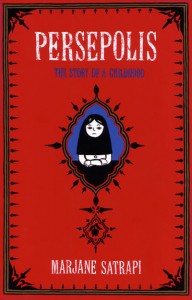Hi guys!
I am back with my second blog post and this week in class we started to read a new piece of text, Persepolis by Marjane Satrapi.
My initial reaction to this graphic novel or comic book was somewhere along the lines of “why in the world are we reading a comic book for my first piece of literature in university?!” But I was not complaining because I would choose a comic book over a 30 page article any day. But I think the real reason why our class had to read this, is because we are learning to interpret different texts. As we have been reading in class, Persepolis is essentially about an Iranian girl who experiences a cultural revolutionary change in her country during the takeover of the Shah’s regime, the triumph of the Islamic Revolution and the devastating effects of the Iran and Iraq War.
Even though the author of the book, Marjane Satrapi, is an Iranian who has lived more than half of her life in Iran, one can question if the story that Marjane wrote about is an accurate or true representation as to what happened realistically. I had a chance to talk with my friend, Sep, and I discovered that her grandmother and mother lived in Iran before, during and after the Islamic Revolution (1979) as well as the Iran-Iraq War. Her mother essentially experienced the role of Marji and her grandmother, Marji’s mother. I personally found that very fascinating and made the graphic text even more compelling as it brought the novel to life! Sep’s “interpretative community” (Shazad, 2011) on how she learned about the Islamic Revolution and Iran-Iraq war was through her family members and using my friend, Sep, as my “interpretative community” (Shazad, 2011), I have gained a deeper insight, in addition to the book, as to what happened during that time. Shazad’s meaning of interpretative communities: “Apart from textual resources, remembering and learning involve a collectivity of significant ‘others’ ” (Shazad, 2011).
Sep’s mother was about seven to eight years old (two-three years younger than Marji) when the Islamic Revolution began in 1979. In 1980, Sep’s mother was forced to wear the hijab or veil and was abruptly split apart from her friends since bilingual and Catholic schools had been shut down. She had a difficult time coping with the new rules since she had been in a Catholic school all her life and she was so young so she did not understand why she had to wear the veil and felt a sense of unhappiness since most of her friends were boys at that time. After the revolution, Sep’s mother was told by the prime leader, Khomeni, that hijabs were optional for women and that was the deal made by him. One day, she was out with her mom (Sep’s grandmother) and they were stopped by two police figures on motorcycles telling them to go back home to put a veil on, but after refusing the police threatened to arrest them and that was when they knew everything was going to change for the worse (Khomeni broke his promise on optional hijabs). As a result, Sep’s family members had migrated away from Iran and the conflict is still present today about the rules of the hijab because of the religious culture that Iran presents. This is homogeneous to Persepolis because of how closely the story is related to what happened realistically, which also answers the question of Marjane’s story and if it is an accurate representation of what actually happened.
For now, that is all the information I have gathered from Sep, and I thought that it was an interesting topic to blog about since I would be bringing the novel to life. I am planning to ask her more about her family history the next time I see her as our class continues to study about Persepolis!
Thanks for reading.
Martin
